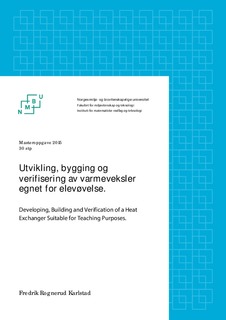| dc.contributor.author | Karlstad, Fredrik Rognerud | |
| dc.date.accessioned | 2015-07-30T11:40:01Z | |
| dc.date.available | 2015-07-30T11:40:01Z | |
| dc.date.copyright | 2015 | |
| dc.date.issued | 2015-07-30 | |
| dc.identifier.uri | http://hdl.handle.net/11250/293980 | |
| dc.description.abstract | Heat exchangers, which task is to recycle or store energy, has been used a lot in the process industry and in everyday appliance, such as radiators in cars or as heating in a living room. There is a lot of theoretical physics associated with heat exchangers, which make them suitable for studying purposes. To obtain high heat transfer rate it is necessary to develop turbulent flow. High heat transfer rate in a heat exchanger will always be at the expense of pressure loss. Therefore, it will be an optimization process to achieve the best heat exchanger. With today’s technology, it is usual to do this optimization using simulation programs, which makes the process far less expensive.
The aim for the thesis was to develop, build and verify a heat exchanger suitable for studying purposes. It should have a simple design, which makes it possible to analyze the heat exchanger manually. The double pipe heat exchanger was chosen to be the most suitable for this purpose. The heat exchanger contains of an inner tube of copper with PVC as the annular pipe. The length of the heat exchanger is about 1 m with a wall thickness about 2 cm.
The heat exchanger was tested and adjusted until the system established energy balance. The system got tested with different flow rates to give different variations between turbulent and laminar flow in the inner and annular pipe. The results from the experiment were compared with a theoretical model developed in Microsoft Office Excel and a CFD - model from SolidWorks Flow Simulation. When the mass flow was turbulent, the deviations of outlet temperature was about 0,1 K. At laminar flow, the difference increased to 1 K for the theoretical model.
The CFD – model was simulated at default settings, achieved by the project wizard in SolidWorks Flow Simulation. The results show that the model provides good estimates for laminar flow, but is not adequate for turbulent flow. This means it requires more manipulation to get great results for an doble pipe heat exchanger with high Reynolds number.
It is shown that the models have an overall great equality to the experiments. The theoretical model is best suitable for turbulent flow and CFD - model provides good estimates for laminar flow. | nb_NO |
| dc.language.iso | nob | nb_NO |
| dc.publisher | Norwegian University of Life Sciences, Ås | |
| dc.rights | Navngivelse 3.0 Norge | * |
| dc.rights.uri | http://creativecommons.org/licenses/by/3.0/no/ | * |
| dc.subject | Varmeveksler | nb_NO |
| dc.subject | Elevøvelse | nb_NO |
| dc.subject | Heat Exchanger | nb_NO |
| dc.title | Utvikling, bygging og verifisering av varmeveksler egnet for elevøvelse | nb_NO |
| dc.title.alternative | Developing, Building and Verification of a Heat Exchanger Suitable for Teaching Purposes. | nb_NO |
| dc.type | Master thesis | nb_NO |
| dc.subject.nsi | VDP::Technology: 500::Environmental engineering: 610 | nb_NO |
| dc.subject.nsi | VDP::Social science: 200::Education: 280 | nb_NO |
| dc.source.pagenumber | 172 | nb_NO |
| dc.description.localcode | M-MF | nb_NO |

